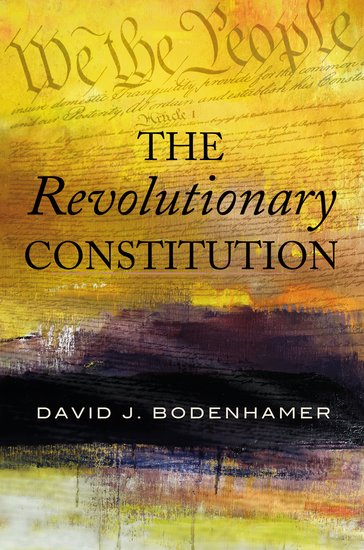By David Bodenhamer
Americans do not question the revolutionary character of the Declaration of Independence. Far fewer view the US Constitution in such terms. It is easy to identify many reasons for this duality. The Declaration speaks in the cadences of Shakespeare and the King James Bible. By comparison, the Constitution is a mechanics manual or lawyers brief. The Declaration offers a concise statement of first principles and goals; it created a nation, and it called for noble sacrifice for the sake of liberty. The Constitution is more procedural. Except for the Preamble, it has few memorable phrases and no peroration to greatness. Too often we see the Constitution as ending the Revolution, when in fact its adoption made it possible to continue the radical impulses that had stirred men and women in 1776.
Abraham Lincoln considered both documents to be the living legacy of the American Revolution. These foundational charters were inextricably linked sources of the nation’s freedom. The Declaration’s principle of equality, he wrote in 1861, was “the apple of gold,” and the Constitution — and the Union it created — was “the picture of silver.” The Constitution was made “not to conceal or destroy the apple but to adorn and preserve it. The picture was made for the apple — not the apple for the picture.” What he did not say but what later generations proven by their actions was that the Constitution was a flexible framework for government because it embodied revolutionary principles, chief among them the radical idea that men and women could rule themselves.
“We the People,” the Constitution’s opening phrase, was no literary conceit. Rather, it represented a fundamental re-scripting of assumptions about government that was embedded in the revolutionary generation’s invention of popular sovereignty, a conception of the people as both rulers and ruled who, in John Jay’s words, “had none to govern but themselves.” This concept allowed power to be divided and thus limited, constraints that were problematic if not impossible when the people only consented to government. Over two centuries, this notion of popular sovereignty has been central to the development of a more democratic and egalitarian nation, as once marginalized and excluded groups demanded to be counted among the people who ruled themselves. But as often happens with revolutionary legacies, there is a counter-narrative to this progressive story. The inventions of popular sovereignty also has produced great mischief. It has offered a veneer of legitimacy to a variety of “isms” — racism, nativism, separatism, and the like — that acted to deny liberty rather than advance it.
The Constitution also established a new but untested and controversial theory about the relationship between power and liberty, the two lodestars of the revolutionary struggle. Early republicanism treated power and liberty as implacable foes, and both the first state constitutions and Articles of Confederation sharply limited governmental power generally as the best way to protect liberty. They likewise elevated the legislature, the people’s representatives, over the executive in distributing power within government. But the emergence of majoritarian tyranny, as the French visitor Alexis de Tocqueville later labeled it, spurred a re-thinking of the calculus of liberty and power. The Constitution proposed a different relationship, one in which governmental power became the friend and promoter of liberty, a result made possible by dividing governmental power among the various branches of the central government and between the national government and the states. And because not all Americans were satisfied with this redefinition of republican ideas, a Bill of Rights placed some rights beyond the power of government. One consequence was that the Constitution came to embody a central tension of the revolutionary thought — government as the friend of liberty, government as the foe of liberty — that has shaped our constitutional politics from the early controversy over the necessary and proper clause to debates over the 2010 heath care reform act.
Above all, the framers of the Constitution aimed to save the great experiment in liberty that had begun in 1776. No one imagined that it had solved the problems that confronted the new nation. Instead, it offered a framework to allow future generations to work out what revolutionary ideas meant for their own circumstances. The founders invited us to struggle over constitutional meaning and in the process to renew the nation’s revolutionary heritage. Ultimately they trusted that we, the people, would answer for ourselves how best to protect and extend Declaration’s promise of liberty and equality.
David J. Bodenhamer is Founder and Executive Director of The Polis Center, Professor of History, and Adjunct Professor of Informatics at Indiana University-Purdue University, Indianapolis. He is the author or editor of several books on American legal and constitutional history, including The Revolutionary Constitution, Fair Trial: Rights of the Accused in American History, and is co-editor of the International Journal of Humanities and Arts Computing.
Subscribe to the OUPblog via email or RSS.
Subscribe to only American history articles on the OUPblog via email or RSS.
View more about this book on the ![]()
![]()


Recent Comments
There are currently no comments.